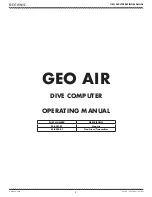
MKS Instruments UK Ltd
HPQ3 Hardware Manual – SP101019.101 October 2012
45
3. Move the lead from the flange and connect to pins 2 through12 on the analyser feedthrough in
turn. Each one should give an open circuit. If not, you have a short to earth.
There are two types of short to earth, an internal short between one part of the analyser
and an earthed part of the analyser, or more commonly, a short between part of the
analyser and the vacuum chamber.
In either case, remove the analyser from the vacuum chamber and repeat the test. If the
result is the same, then you have an internal short and should contact your local MKS
facility for advice.
Otherwise, you have a short to the vacuum chamber, check the dimensions of the vacuum
chamber around the quadrupole analyser against the dimensions provided on Page 6 of this
manual, or try refitting the analyser in a slightly different orientation.
Repeat the ohmmeter tests before pumping down the vacuum chamber. Remember that the ion
source gets very hot during operation and the stainless steel components will expand slightly.
Sometimes a short will only develop when the analyser has been run for a while and is up to
temperature.
4. Move the meter lead from pin 1 and attach it to pin 2 of the analyser feedthrough. Connect the
other lead to pins 3 through 12 on the analyser feedthrough in turn. Each one should give an open
circuit.
Now move the meter lead from pin 2 to pin 3 and check to pins 4 to 12. Proceed around the
feedthrough until all possible connections have been checked.
All the pins should show an open circuit to all other pins, EXCEPT pin 4 to 8 and pin 8 to 10, which
should show short-circuit as these are the filament connections.
If any of the pins read short-circuit to another pin, contact your local MKS service centre with the
results of your tests and they will advise you how to proceed.
7.3 Checking filaments
The status of the filaments is constantly monitored by the HPQ3and the operating software. This is
achieved by measuring the flow of electrons emitted by the hot filament, referred to as the
emission current, flowing to the ion source cage.
This is normally maintained at a fixed value of 1mA. The current flow through the filament is
increased until the value of emission current is reached. If, however, the control electronics
reaches the limit of its filament current supply capability and the emission current has still not
reached 1mA, a filament fail condition will exist.
In the vast majority of cases this will be due to a blown filament, more correctly described as an
open circuit filament. There are other conditions, such as a heavily contaminated ion source, which
will result in a filament fail condition when the filament is not open circuit.
Summary of Contents for HPQ3
Page 1: ...HPQ3 S Hardware Manual HPQ3 Hardware Manual SP101019 101 October2012...
Page 10: ...MKS Instruments UK Ltd HPQ3 Hardware Manual SP101019 101 October 2012 10...
Page 15: ...MKS Instruments UK Ltd HPQ3 Hardware Manual SP101019 101 October 2012 15...
Page 28: ...MKS Instruments UK Ltd HPQ3 Hardware Manual SP101019 101 October 2012 28...
Page 49: ...MKS Instruments UK Ltd HPQ3 Hardware Manual SP101019 101 October 2012 49 Fig 1 Fig 2...
Page 54: ...MKS Instruments UK Ltd HPQ3 Hardware Manual SP101019 101 October 2012 54 Fig 1 Fig 2...
Page 60: ...MKS Instruments UK Ltd HPQ3 Hardware Manual SP101019 101 October 2012 60...
















































